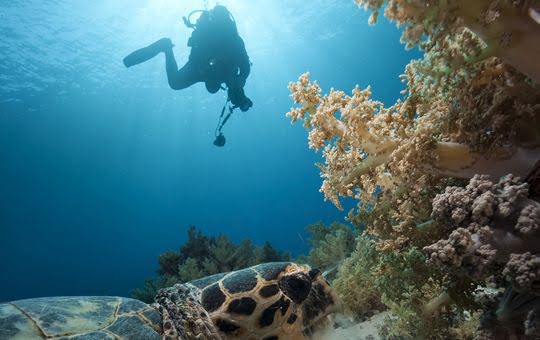 Excluded
Excluded
- Flighttickets, Visa, Meetingassistant, , Crewtipps, Alkohol


Deep, deep in the south - near Rocky Island - are the St. John’s Reefs. You will find their exciting drop-offs. The wall of one of the reefs is overgrown with big gorgonians, and the wall of the other reef is overgrown with all kinds of colorful soft corals.
You will find a lot of fish, and in the blue, you can see with a little bit of luck “big fish” like Hammerheads, Grey sharks, Silvertip, White Tip Reef Sharks, Barracudas, Tunas, and Mackerels. Sometimes even you can see Mantas and dolphins.
It is possible to reach St. John’s Reefs in one week, but you are going to sail a lot (mostly at the night) and the time is very short to dive at all the reefs in St. John’s.
Because of the long distance, some groups decide to do a 10 or 13 days safari cruise in combination with Abu Fendera.
Abu Fendera: The main reef is around 6 km long and full of hard coral. In front of this reef, you can see some parts like a small reef or ergs, which are 400 – 800 meters.
You can go diving between the reefs. So, you can plan and make a lot of different dives there. In front of the reefs, you will see a lot of ergs. And there are the most beautiful soft corals. Also, you can see a lot of fish.
Note: ABU FENDERA on request.
The corner and outside north of Shouna is unique for its sprawling sand plateau. Littered in table corals of all shapes and sizes, pick your depth on the gradual slope and see what's hiding beneath each one. Of course blue spot rays are abundant, but certain times of year bring in breeding guitar rays and other surprises.
Large 6 mile long horseshoe shaped reef. In the lagoon some families of dolphins have been living for a long time, easy to meet. It is an excellent place to see some hunters.
Abu Galawa: Here a wreck lies in 18 m, which sank in the 50’s. It is so overgrown with all kinds of hard corals, that it takes a little bit time till you recognize the bridge, rail and the funnel of the ship. The wreck is very appealing for every photographer. Also it is nice to do a night dive at Abu Galawa. With a little bit luck, you can see a Spanish dancer.
This long finger like reef runs from north to south in the open Red Sea. Steep walls drop to the depths on the reef’s east and west sides, while the north and south ends of the reefs are marked by submerged plateau. Sharks often swim by the spot to feed on the abundant reef fish population.
This massive reef system is located furthest south, 10 miles from the Sudanese border. There are dozens of excellent dives. Its reefs rise up from a gigantic underwater plateau hidden in the inky blue water.
A huge reef with plenty of life. Big chance to see seahorse in the sea grass.
A barrier in front of the last inhabited city south of the Egyptian coast. Here the coral gardens form large blocks that are full of flag fish, jack fish, triggerfish and platax.
Abu Dabbab is one of the most famous dive sites in the Red Sea and of all of Egypt. It is one of the few places in the world where you can dive with the very rare and endangered Dugong aka the Sea Cow. In fact, there are two resident Dugongs in the Abu Dabbab bay named Dennis and Dougal. This dive site also features friendly giant Green Sea Turtles that you can swim with up close and personal. In the shallow water, it is not rare to spot the bizarre looking but completely harmless Guitar Shark. In addition to the big stuff, there are also superb macro subjects such as the ornate Ghost Pipefish, the rare thorny seahorse and the delicate Hairy Pygmy Pipehorse!
The Fury Shoals make up several reefs along the Southwest Red Sea coast, offering amazing scuba diving opportunities with some of the most pristine reefs in Egypt. The hard and soft coral are unspoiled and are a highlight of many dive sites such as the Fury Shoal Garden. The marine life is also really great with all the usual reef fishes of the Red Sea and various species of reef Sharks (Whitetip, Grey) and even sometimes the curious Oceanic Whitetip Shark. Pelagic fishes such Barracudas, Giant Trevallies, Dogtooth Tunas are also common in the area.

